Many countries around the world, especially developed ones like Japan, Italy, and Germany, are experiencing declining birth rates and an ageing population.
According to the United Nations, by 2030, 1 in 6 people will be 60 or older, and by 2050, the number of people aged 60 and above will double.
Australians, for instance, are getting older – and fast. The University of Sydney predicts that by 2026, over 22% of Australians will be over 65 or older.
The implications are staggering, and we might ask, how will it impact Australia moving forward?
Read on to know more.
Understanding Aged Care in Australia
An ageing population will shift a country’s structure, requiring the government to address the needs of older communities. This includes building more healthcare centers, senior gyms, and investing in elderly care instead of schools and playgrounds.
For example, the Australian government has various programs and policies to support its ageing population. The Department of Health and Aged Care is the main agency responsible for providing the necessary support, helping older people with daily living and other needs.
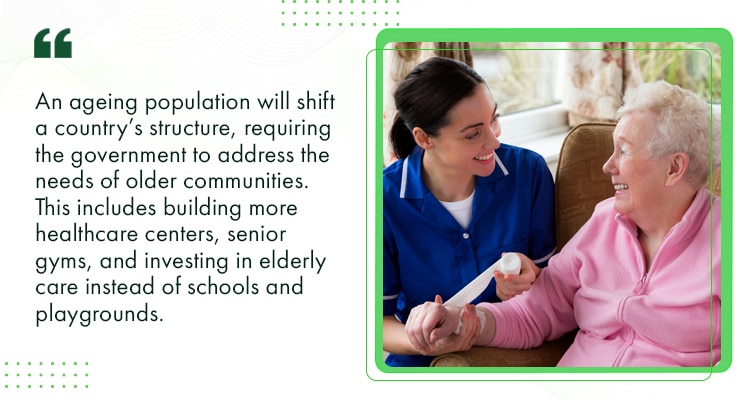
By 1 July 2025, the new Aged Care Act, an amendment to the Aged Care Act 1997, will be implemented to respond to the issues facing older people, putting their rights and needs at the centre of the Australian aged care system, particularly:
- Improved quality of care;
- Increased transparency and accountability;
- Enhanced workforce conditions; and
- Increased funding.
What is Aged Care?
Aged care refers to support provided for older people who need help at home or can no longer live independently. It assists them with:
- Everyday living;
- Assistive equipment and home modifications;
- Personal and health care; and
- Accommodation.
Elderly care typically includes home care (services delivered at home); residential aged care (care in nursing homes); and short-term care (temporary care for older adults).
Regardless of its type, aged care aims to:
- Support older people with daily tasks;
- Help older adults live with dignity and maintain their quality of life;
- Assist those who can no longer live independently; and
- Keep older people connected to their community.
Who is Eligible for Aged Care?
In Australia, eligibility for government-funded aged care services depends on age and assessed care needs.
Age and Health Criteria
Generally, you must be 65 or older to qualify. However, Aboriginals or Torres Strait Islanders can access services from age 50. In some cases, younger people with specific care needs may also be eligible.
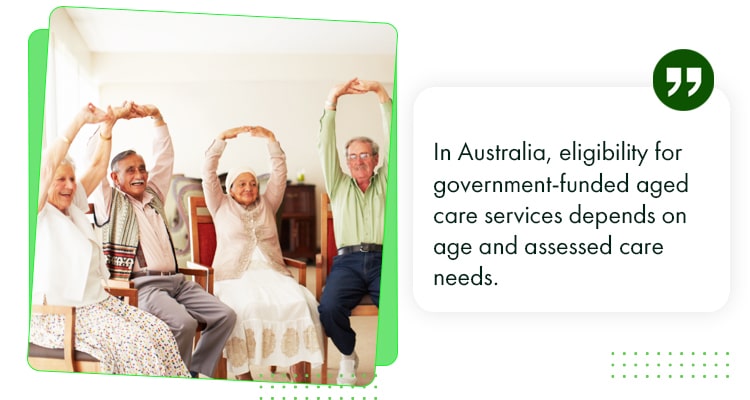
Eligibility is also based on a person’s need for assistance. For example, you’re more likely to receive comprehensive support if you have:
- Difficulty with personal care, like bathing or dressing;
- Challenges with household tasks, such as cooking or cleaning;
- Mobility issues;
- Cognitive impairment; or
- A need for ongoing healthcare.
Government Assessments and Approval Process
The Australian government requires individuals to contact My Aged Care, the main source for all elderly care information and services.
To determine your eligibility, you will need to undergo assessments, namely:
- Regional Assessment Services (RAS) – For people who require entry-level support; or
- Aged Care Assessment Teams (ACATs) – For those with more complex care needs.
After the assessment, you will be informed if you’re eligible for government-funded elderly care services. If approved, you can work with My Aged Care to find suitable service providers.
Types of Aged Care Services
There are four types of aged care services available for Australians. Let’s take a look:
#1. Home-Based Care
In-home aged care helps older people stay independent by providing support at their residence, allowing them to remain in familiar surroundings.
This support typically helps with:
- Personal care
- Transport
- Food preparation
- Shopping
- Housework
- Social activities
- Therapy
- Home modifications
Under this model, the Australian government can subsidise entry-level care through the Commonwealth Home Support Programme, while more complex needs are covered by Home Care Packages.
Individuals can also choose home care services from private providers, offering greater flexibility and specialised services, though they are usually more expensive.
#2. Residential Care in Aged Care Homes
Meanwhile, residential care is for older people who can no longer live at home or need ongoing help with daily tasks or healthcare.
Nursing Homes v. Assisted Living
Nursing homes offer 24-hour care, including personal care, nursing care, accommodation, meals, and social activities, especially for those with complex medical needs.
In contrast, assisted living is for individuals who need help with daily activities but don’t require constant medical supervision.
Either way, the Australian government subsidises aged care homes to provide 24-hour care, including access to nursing and general healthcare services.
Accreditation and Standards
To receive government funding, aged care facilities must be accredited by the Aged Care Quality and Safety Commission, the national regulator of aged care services.
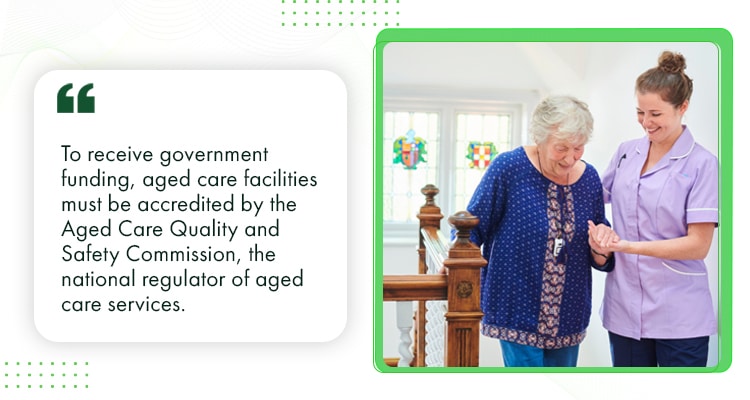
This process usually involves demonstrating compliance with Australian quality standards, often with the help of an outsourcing company or offshore service providers for tasks like documentation, reports, and administration.
#3. Short-Term Care
Short-term care is also available for those who need help improving their well-being and independence or recovering after a hospital stay.
The AU government subsides the following:
- After-hospital or transition care support for up to 12 weeks;
- Short-term restorative care for up to 8 weeks; and
- Respite care for a few hours.
Respite Care for Caregivers
Respite care gives family members or caregivers a break by providing temporary relief in the following ways:
- In-home Respite – A care worker visits the older adult’s home;
- Day Respite – The older adult attends a day center for social activities; or
- Residential Respite – The older adult stays in a residential care facility for a short time.
Rehabilitation and Transitional Care
Meanwhile, rehabilitation care helps older adults regain independence after illness, injury, or surgery with occupational therapy, physiotherapy, and speech therapy.
Transitional care, on the other hand, supports individuals moving from hospital to home or other care settings, ensuring a smooth transition and preventing re-admissions.
#4. Retirement Villages (or Retirement Homes)
Lastly, retirement villages are for those who do not need the higher level of care provided by aged care homes.
These are designed for seniors who are generally independent and want to downsize or live in a community with like-minded individuals.
The Australian government does not subsidise this type of senior living, so individuals must pay the full cost themselves; however, there is government guidance for those considering it.
How to Access Aged Care Services
The following step-by-step guide will help you get started:
Step 1. Check Your Eligibility.
Go to the My Aged Care website and check if you’re eligible, such as when you’re 65 years or older and have:
- Noticed a change in what you can do or remember;
- Been diagnosed with a medical condition or have reduced mobility;
- Experienced changes in family care arrangements; or
- Had a recent fall or hospital admission.
Step 2. Undergo an Initial Assessment.
Next, apply for an assessment. My Aged Care will ask questions about your health, daily activities, and support needs through a 15-minute online questionnaire. This helps determine the type of assessment you may need.
After the evaluation, you will receive feedback outlining the outcomes and any approved services. If you qualify for government-funded services, the letter will specify the type and level of care you can receive.
Step 3. Find a Service Provider.
My Aged Care will help you find a provider near you. However, it’s still important to research and compare options to find one that suits your needs and preferences.
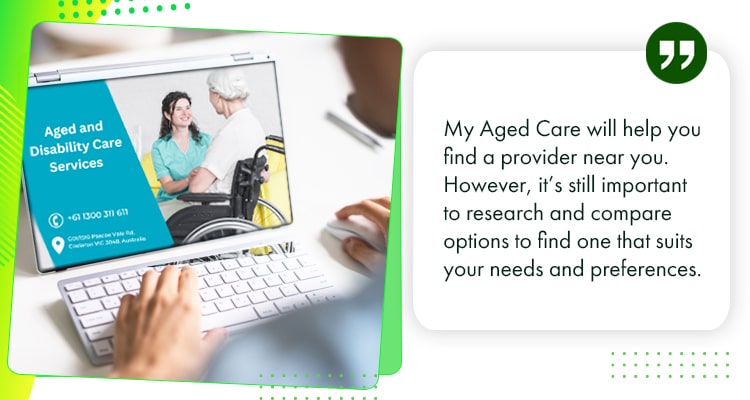
For instance, many Australians prefer healthcare providers with Filipino caregivers, known for their skills and genuine care for their patients. These providers also offer strong online support by outsourcing efficient customer service through remote team outsourcing or global outsourcing firms.
Costs of Aged Care in 2025
Senior living can be expensive due to increased healthcare needs, caregiver support, and medical costs. Thus, here are some key factors to consider when it comes to expenses:
Government Subsidies and Funding Models
The Australian government pays approved providers a subsidy for each person receiving government-subsidised aged care. These subsidies include:
- Residential Aged Care Subsidy
- Home Care Package Program Subsidy
- Residential Respite Subsidy
- Flexible Care Subsidy for the Short-Term Restorative Care Programme
- Flexible Care Subsidy for the Transition Care Programme
Moreover, they provide supplements in addition to subsidies to cover the costs of meeting specific care needs.
Out-of-Pocket Expenses for Families
Even with government subsidies, families may still face out-of-pocket expenses because the government doesn’t cover:
- Basic daily fees for residential aged care;
- Accommodation costs;
- Extra fees for specific services or amenities; and
- Homecare package fees.
However, the amount of out-of-pocket expenses can differ depending on an individual’s circumstances. For instance, if your income is below $33,735 or your assets are below $61,500, the Australian government will cover your accommodation costs.
Changes in Aged Care Pricing Regulations
What you pay and how much will depend on your income, assets, the level of care required, and the home you choose.
Thus, before choosing a provider, it’s a good idea to estimate your costs using a fee estimator. After that, you can use the income and assets checklist for more details.

Under the new Aged Care Act, the government will conduct assurance reviews to ensure home care providers use funding properly to deliver services to older people.
Additionally, the Aged Care Financing Authority will be abolished and replaced by the Independent Health and Aged Care Pricing Authority.
Quality and Regulation of Aged Care Services
With the new Aged Care Act, the Australian government aims to empower older people to exercise their rights to Commonwealth-funded aged care services.
Here’s how:
Government Oversight and Compliance in 2025
The new Act aims to improve how services are delivered to older people in their homes, communities, and approved nursing homes.
It also establishes a new system of oversight and accountability, including increased provider responsibility through a new regulatory model.
Key Reforms and Royal Commission Findings
The Royal Commission’s findings have led to significant reforms in aged care, including:
- Enhanced protection of residents’ rights;
- Increased focus on person-centred care;
- Improved workforce training; and
- Strengthened governance and accountability for aged care providers.
How to Ensure High-Quality Care for Your Loved Ones
It’s important to research aged care providers in your area.
Once you have a list, check their compliance history and quality ratings on the Aged Care Quality and Safety Commission’s website. You can also visit the facilities in person to observe the environment and the interactions between staff and residents.
Moreover, you can:
- Ask Questions – Don’t hesitate to ask questions about the provider’s policies, procedures, and staffing levels.
- Stay Informed – Familiarise yourself with the rights of aged care recipients and regularly visit to observe the care being provided.
- Utilise Government Resources – Take advantage of resources provided by government agencies, understand the complaint process, and make use of it if needed.
Frequently Asked Questions
Here are some frequently asked questions about Australia’s aged care:
#1. What Changes Have Been Made to Aged Care Services in Australia in 2025?
The new Aged Care has the following key changes:
- Updated rules to fix gaps in guardianship and consent laws across states and territories;
- Improved financial oversight of residential accommodation deposits;
- Strengthened governance for care providers;
- Introduced a star rating system for residential aged care services; and
- Expanded the Serious Incident Response Scheme to cover home care and flexible care in home or community settings.
#2. How Do I Know if My Loved One Qualifies for Aged Care Assistance?
The first step is an assessment to determine your loved one’s care needs and support level. You can contact My Aged Care for information and services, or visit their website for more details and to arrange an assessment.
Aside from the care needs assessment, a financial assessment will be done to determine your loved one’s eligibility for government subsidies. This will review income and assets to decide if subsidies, supplements, or full funding are needed.
#3. What Are the Key Factors to Consider When Choosing an Aged Care Facility?
Choose a facility that is easy for family and friends to visit, and consider its proximity to medical services and transportation.
Moreover, research the facility’s quality ratings, staff-to-resident ratios, staff qualifications, and training. Consider the layout as well, including common areas, dining rooms, and outdoor spaces.
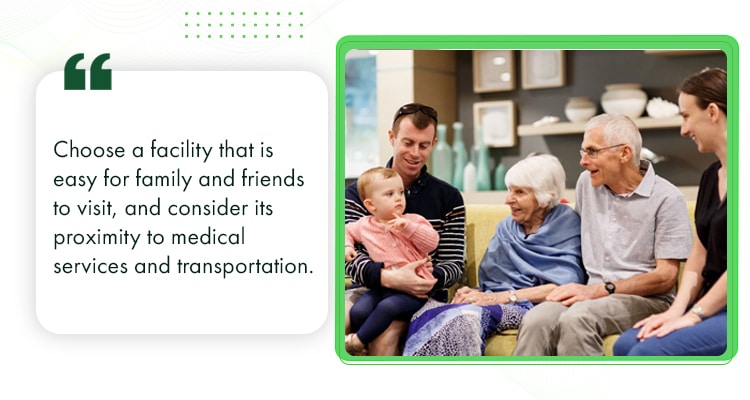
Here are some additional factors to consider:
- Reputation and reviews from other families;
- Range of services and activities offered;
- Available government subsidies, and financial assistance options;
- Ability to personalise care based on individual needs; and
- Online reviews and testimonials.
Conclusion
While ageing is inevitable, there are ways to ensure all Australians receive more dignified and supportive aged care.
Governments must provide healthcare, subsidies, and support for the elderly, while families should consider options like home-based care, aged care homes, short-term care, or residential villages to offer the best support for their senior loved ones.
Lastly, if you’re an Australian healthcare provider, you should offer comprehensive services and programs that address the evolving needs of the elderly, utilising digital technology or artificial intelligence.
For more information on finding skilled professionals to help your healthcare business go digital, call us today or request a callback now.
- Want to know how to hire Filipino virtual personal assistants effectively? Learn more here.
- Ready to Build a FULLY Remote Team with the Right People? Click here.
- Check Out Our 1,000 Fully Vetted and Highly Talented Staff here.
Syrine is studying law while working as a content writer. When she’s not writing or studying, she engages in tutoring, events planning, and social media browsing. In 2021, she published her book, Stellar Thoughts.




















